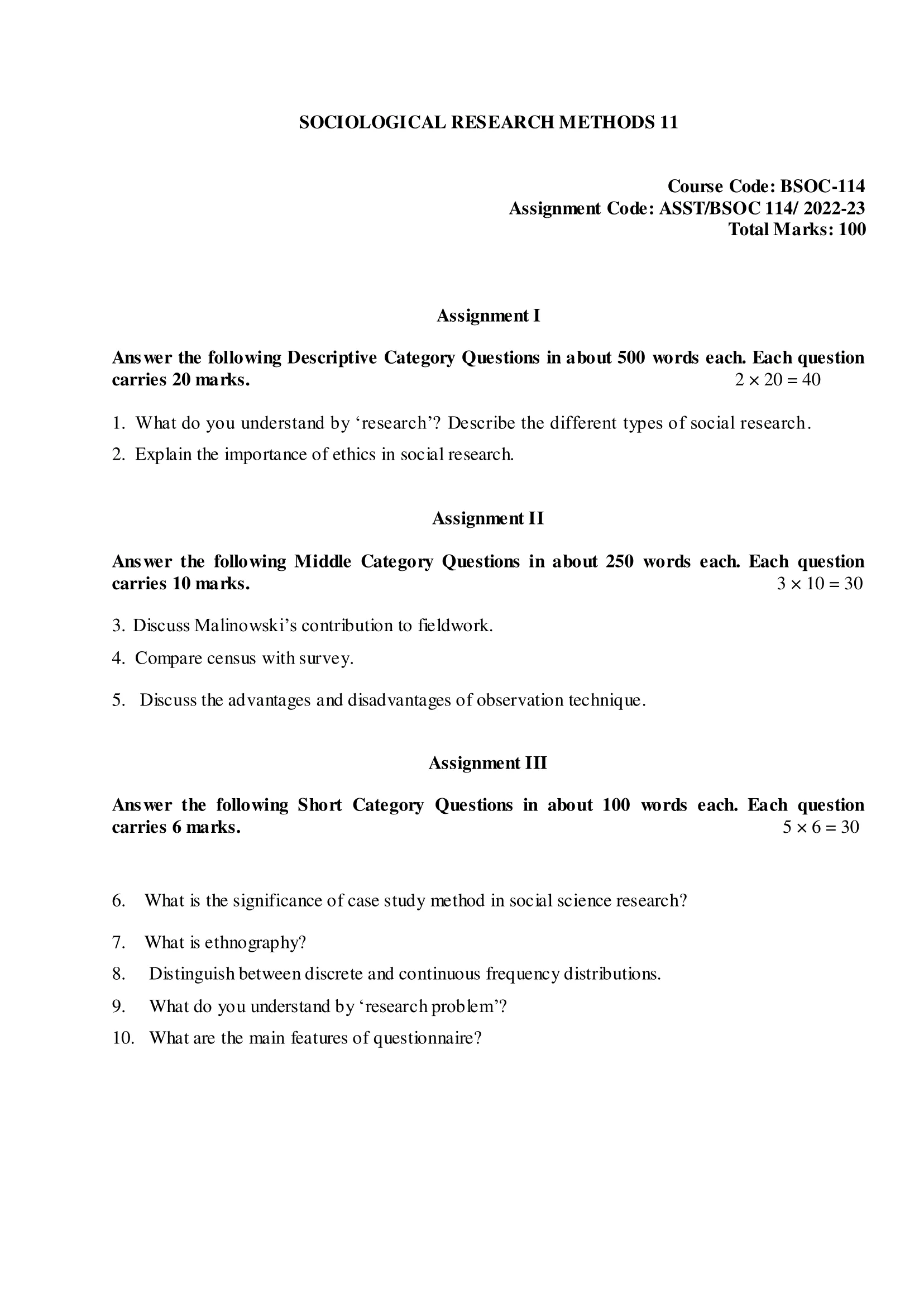
| Title | BSOC-114: IGNOU BAG Solved Assignment 2022-2023 |
| University | IGNOU |
| Degree | Bachelor Degree Programme |
| Course Code | BSOC-114 |
| Course Name | SOCIOLOGICAL RESEARCH METHODS-II |
| Programme Name | Bachelor of Arts (General) |
| Programme Code | BAG |
| Total Marks | 100 |
| Year | 2022-2023 |
| Language | English |
| Assignment Code | ASST/BSOC 114/ 2022-23 |
| Assignment PDF | Click Here |
| Last Date for Submission of Assignment: | For June Examination: 31st April For December Examination: 30th September |

Assignment I
Answer the following Descriptive Category Questions in about 500 words each. Each question carries 20 marks.
1. What do you understand by ‘research’? Describe the different types of social research.
Ans: Research is a systematic and scientific approach to discovering new knowledge and understanding of a particular phenomenon. It is a process of collecting, analyzing, and interpreting information to answer questions and solve problems. Research is an essential component of many fields, including social sciences, natural sciences, engineering, and medicine, among others. In this context, social research refers to the systematic investigation of social issues, behavior, and patterns. Social research aims to explain, predict, and evaluate social phenomena by collecting and analyzing data from a specific population.
Types of social research:
- Quantitative research: This type of research involves the collection and analysis of numerical data. It relies on statistical analysis to explain social phenomena. Quantitative research methods include surveys, experiments, and statistical analysis of secondary data. Surveys involve collecting data from a sample of individuals using standardized questionnaires. Experiments involve manipulating variables to test cause-and-effect relationships. Statistical analysis of secondary data involves analyzing data from existing sources, such as census data.
- Qualitative research: Qualitative research is an exploratory research method that aims to understand social phenomena in-depth. It relies on non-numerical data, such as observations, interviews, and focus groups. Qualitative research aims to generate theories and hypotheses by exploring the subjective experiences of individuals. This type of research is useful in cases where little is known about a particular social phenomenon.
- Mixed-method research: This type of research combines both quantitative and qualitative research methods to gain a more comprehensive understanding of social phenomena. Mixed-method research involves collecting and analyzing both numerical and non-numerical data. This type of research is useful when a researcher wants to validate and contextualize their findings from one method with the other.
- Action research: Action research is a collaborative research method that aims to identify and solve practical problems in a specific context. It involves collaboration between researchers and practitioners to improve practices in a particular field. Action research is useful in fields such as education, health care, and community development.
- Ethnographic research: Ethnographic research involves immersing oneself in a particular community or culture to understand social phenomena from an insider’s perspective. This type of research involves participant observation and interviews with members of the community. Ethnographic research aims to understand the social, cultural, and historical contexts that shape social phenomena.
2. Explain the importance of ethics in social research.
Ans: Ethics is a fundamental aspect of social research that ensures that research is conducted in a responsible and trustworthy manner. Social research involves the study of human behavior and interactions, which raises complex ethical issues related to human subjects’ protection and privacy. Ethics in social research refers to the principles and standards that guide researchers’ conduct and ensure that research is conducted in an ethical and responsible manner.
The importance of ethics in social research can be described in the following ways:
- Protection of human subjects: One of the primary ethical considerations in social research is the protection of human subjects’ welfare. Ethical research requires that researchers obtain informed consent from participants, protect participants’ confidentiality, and avoid any harm or exploitation. Ethical research ensures that participants are not put at any unnecessary risk and that their rights and dignity are respected.
- Maintaining public trust: Social research is often funded by public money and has implications for public policy. Ethical research ensures that research findings are reliable, valid, and unbiased, which increases public trust in research findings. Researchers must adhere to ethical principles to maintain the integrity of the research process and ensure that research findings are accepted by the public.
- Avoiding harm: Social research has the potential to harm individuals or groups involved in research. Ethical research ensures that researchers do not cause any harm to participants, communities, or society. It is important to ensure that participants are not put at any unnecessary risk, and that the research benefits outweigh any potential harm.
- Promoting integrity and accountability: Ethical research promotes integrity and accountability in the research process. Researchers must adhere to ethical principles such as honesty, transparency, and rigor in research design, data collection, analysis, and reporting. Ethical research ensures that researchers take responsibility for their actions and that research findings are not manipulated or distorted.
- Avoiding bias and discrimination: Ethical research ensures that researchers avoid bias and discrimination in the research process. Researchers must ensure that research is inclusive, diverse, and representative of the population being studied. Ethical research also requires that researchers avoid any discriminatory practices or stigmatization of certain groups.
Assignment II
Answer the following Middle Category Questions in about 250 words each. Each question carries 10 marks.
3. Discuss Malinowski’s contribution to fieldwork.
Ans: Bronislaw Malinowski is considered one of the most influential anthropologists in the history of the discipline. He is particularly known for his significant contributions to fieldwork methodology, which revolutionized the way anthropologists conducted research.
Malinowski’s most significant contribution to fieldwork was the development of participant observation. This method involves living and participating in the culture being studied, which allowed Malinowski to gain an in-depth understanding of the social organization and culture of the people he was studying. By spending years in the Trobriand Islands, he was able to build close relationships with the people and become fluent in the local language. This allowed him to observe and document social practices, beliefs, and customs from an insider perspective. This approach is still widely used in anthropological research today.
Malinowski also developed the concept of functionalism, which emphasizes the interconnectedness of various cultural practices and institutions. He believed that every aspect of a society serves a specific function and contributes to the overall functioning of the society as a whole. This idea allowed him to develop a comprehensive understanding of the social organization of the Trobriand Islanders and how their various cultural practices and institutions were interconnected.
Furthermore, Malinowski was instrumental in developing the idea of ethnographic realism. He believed that fieldwork should be conducted in a rigorous and systematic manner, with the aim of producing an accurate and detailed account of the culture being studied. He emphasized the importance of collecting detailed and comprehensive data, including the use of field notes, audio recordings, and photographs. This data was then used to write ethnographic accounts that presented an accurate and nuanced portrayal of the culture being studied.
4. Compare census with survey.
Ans: Census and survey are two methods of data collection used to gather information about a population or a sample of a population. While both methods can be used to collect valuable data, there are some key differences between the two.
A census is a complete enumeration of a population, meaning that data is collected from every individual in the population. Census data is typically collected by a government agency, and it can provide a wide range of demographic, social, and economic information about a population. Census data is often used for research, planning, and policymaking purposes.
On the other hand, a survey is a method of collecting data from a sample of a population. Surveys are typically conducted by researchers, and they involve administering a set of questions to a sample of individuals who are representative of the larger population. Surveys can be conducted through various methods, including online, by phone, or in person, and they can be used to gather a wide range of information on topics such as attitudes, beliefs, behaviors, and experiences.
One of the main advantages of a census is that it provides a complete picture of the population being studied, with no room for sampling error. However, a census can be expensive and time-consuming to administer, and it may not be necessary for all research or planning purposes. A survey, on the other hand, can be more cost-effective and can provide valuable information about a specific subset of the population. However, surveys rely on representative sampling to ensure that the data collected is accurate and reliable, and this can be challenging to achieve.
5. Discuss the advantages and disadvantages of observation technique.
Ans: Observation is a data collection method widely used in social sciences and other fields. The method involves systematically watching and recording behavior, activities, and events in a specific setting. While observation can be a powerful and valuable research tool, there are several advantages and disadvantages to using this technique.
Advantages of Observation:
- Naturalistic Setting: Observation can be carried out in a naturalistic setting, meaning that individuals are observed in their everyday environment. This allows researchers to collect data on real-life behaviors and interactions.
- Unobtrusive: Observational research is unobtrusive, meaning that individuals being observed are not aware that they are being watched. This can lead to more natural behavior and interactions, as individuals may behave differently if they know they are being watched.
- Rich and Detailed Data: Observation allows researchers to collect rich and detailed data, including non-verbal behaviors, body language, and facial expressions. This can provide insight into the attitudes, beliefs, and values of individuals, and can provide a more complete picture of the phenomena being studied.
Disadvantages of Observation:
- Observer Bias: Observation is subject to observer bias, which occurs when the researcher’s personal beliefs, values, and attitudes influence the interpretation of the data. This can lead to inaccurate or incomplete data.
- Limited Generalizability: The data collected through observation is specific to the setting and individuals being observed. Therefore, it may not be generalizable to other populations or settings.
- Ethical Concerns: Observational research raises ethical concerns regarding the privacy and confidentiality of individuals being observed. The individuals may not be aware they are being observed, which can raise ethical concerns about informed consent.
- Limited Interaction: Observation is limited to what can be seen and heard in the environment being studied. Therefore, it may not provide information about the attitudes, beliefs, and motivations of the individuals being observed.
Assignment III
Answer the following Short Category Questions in about 100 words each. Each question carries 6 marks.
6. What is the significance of case study method in social science research?
Ans: The case study method is a valuable research method in social science research. It is a comprehensive and in-depth investigation of a particular social phenomenon or individual. The significance of case study method lies in its ability to provide detailed and nuanced insights into complex social phenomena. It is particularly useful in situations where the research question is unique, and there is little prior knowledge on the topic. The case study method is also valuable in exploring the context and history of the phenomenon, which can be difficult to capture using other research methods. Overall, the case study method provides rich and detailed data that can inform theory development and guide policy decisions.
7. What is ethnography?
Ans: Ethnography is a research method used in social sciences, particularly in anthropology and sociology, to study and describe human cultures, communities, and social interactions.
Ethnography typically involves the systematic collection of qualitative data through methods such as participant observation, interviews, and analysis of documents and artifacts. The goal is to gain an in-depth understanding of the social and cultural practices, beliefs, values, and norms of a particular group of people.
Ethnography often involves spending an extended period of time with the community being studied, immersing oneself in their daily lives, and observing and interacting with them in a naturalistic setting. Ethnographers strive to minimize their own biases and cultural assumptions and to describe the culture they are studying from the perspective of the people who are part of it.
The resulting ethnographic account can take many forms, including a detailed narrative description, a case study, or an analysis of the social and cultural processes at work in the community. Ethnography is widely used in academic research, as well as in applied fields such as market research, design research, and user experience research.
8. Distinguish between discrete and continuous frequency distributions.
Ans: Discrete and continuous frequency distributions are two types of distributions commonly used in statistics.
A discrete frequency distribution is a distribution that has a finite number of possible values or categories, with no values in between. Each possible value or category has a count or frequency associated with it, representing the number of times that value or category appears in a given data set. For example, the number of children in a family is a discrete variable, as it can only take on specific integer values (e.g. 0, 1, 2, 3, etc.). The frequencies in a discrete distribution are usually represented as bars in a histogram.
A continuous frequency distribution, on the other hand, is a distribution that has an infinite number of possible values or categories, with values that can take on any value within a range or interval. The frequencies in a continuous distribution are represented by the area under a curve, which is typically a smooth, continuous function. Continuous variables can take on any value within a given range, and are often measured on a scale that includes decimal values. Examples of continuous variables include age, height, weight, and temperature.
9. What do you understand by ‘research problem’?
Ans: A research problem is a specific, clearly defined, and well-formulated issue that a researcher wants to investigate through a systematic and scientific inquiry. It refers to the question or issue that a researcher seeks to answer or address through their research study.
A research problem typically arises from a gap in knowledge or an area that has not been sufficiently studied, and it often seeks to address a practical or theoretical problem or challenge. The problem statement should be specific and focused, and it should clearly articulate the purpose of the research study.
To develop a research problem, a researcher typically engages in a process of reviewing relevant literature, identifying gaps or unanswered questions, and considering their own interests, expertise, and the potential impact of their research. The research problem guides the development of research questions or hypotheses, the selection of research methods, the collection and analysis of data, and the interpretation and communication of findings.
A well-formulated research problem is important because it helps ensure that a research study is relevant, feasible, and contributes to the existing body of knowledge. It also helps to provide focus and direction to the research process, and to guide decisions about study design and methodology.
10. What are the main features of questionnaire?
Ans: A questionnaire is a research tool used to collect data from individuals about their attitudes, beliefs, behaviors, experiences, and opinions on a specific topic. The main features of a questionnaire include:
- Structured Format: A questionnaire is typically structured with a set of questions that are organized in a logical and coherent manner.
- Closed-Ended Questions: Questionnaires often use closed-ended questions, which provide respondents with a set of predetermined response options to choose from. This makes the data collection process more efficient and easier to analyze.
- Standardization: Questionnaires are designed to be standardized, meaning that the same questions are asked of each respondent in the same way. This ensures that the data collected is consistent and comparable across respondents.
- Pre-Testing: Prior to being administered, questionnaires are typically pre-tested with a small group of respondents to identify any potential issues or problems with the questions.
- Anonymity: Questionnaires can be administered anonymously, meaning that respondents are not required to provide identifying information. This can increase the likelihood that respondents will provide honest and accurate responses.
How to Download BSOC-114 Solved Assignment?
You can download it from the www.edukar.in, they have a big database for all the IGNOU solved assignments.
Is the BSOC-114 Solved Assignment Free?
Yes this is absolutely free to download the solved assignment from www.edukar.in
What is the last submission date for BSOC-114 Solved Assignment?
For June Examination: 31st April, For December Examination: 30th October





